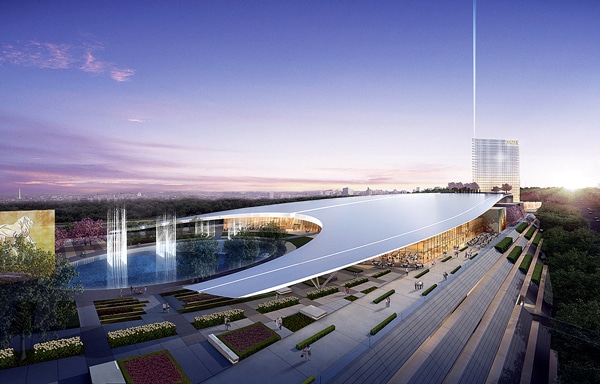Sleek, low-slung, and encased in glimmering glass, MGM National Harbor aims to stand side-by-side with its sister resorts as an international travel destination in MGM Resorts International’s portfolio. Perched on the banks of the Potomac River, it will serve as a beacon, calling invitingly to the dignitaries and high-rollers just upstream in Washington D.C. Totaling 1 million square feet, visitors will find all of the expected accouterments that come with a life of luxury: more than 300 rooms, a conference center, gaming floor, and a spa alongside restaurants and retailers.

Upon completion, MGM National Harbor aims to be one of the largest properties to be certified as LEED Gold.
At first glance, there may seem to be nothing subtle about this world-class resort, but at its very foundation, the designers and builders have diligently sought a way to blend MGM National Harbor into its environment and provide benefits to the community. Plus, the local largess will include thousands of new jobs for residents and a boost to the local tax base from both gaming and non-gaming taxes, as well as provide additional revenue from the tourists drawn to the resort. And on a more fundamental level, the resort has been optimized to lessen its impact on the environment and provide a sustainable source of income and diversion for generations to come.
Following the success of their CityCenter project in Las Vegas, MGM Resorts International (MGM) has reaffirmed its dedication to sustainable building practices, as every new project has the goal of reaching LEED Gold certification. “We believe in being great community partners in the areas where we have the opportunity to operate,” says Todd Megrath, executive director of sustainable development at MGM. “Sustainability and reduction of environmental impact is something that helps us be better corporate citizens.”
MGM National Harbor is no exception. Led by Russell Perry, vice president and co-director of sustainable design at SmithGroupJJR—architecture firm of record—every construction partner, contractor, and provider was vetted in an effort to achieve enterprise-level focus on sustainable practices.
The result is a resort that takes great strides forward in green design in ways both overt—like the 750,000 gallon cistern that will collect rainwater—to subtle, like the eco-conscious concrete masonry blocks used in the resort’s foundation. The latter provides a perspective from which to examine the unique attention to detail that can result in significant lessening of the resort’s environmental impact.
At the request of Perry, the 195,000 concrete masonry blocks used in the construction of MGM National Harbor were sourced through Maryland-based Ernest Maier. The company manufactures their concrete masonry using proprietary technology from CarbonCure, which introduces CO2 gas captured from smokestack emissions into concrete, where it becomes safely and permanently converted into a calcium carbonate mineral.

CarbonCure Installation Manager Diane Praught demonstrates the CarbonCure computer interface, which controls the injection of carbon dioxide gas into concrete mix.
The cement industry is historically one of the largest CO2 culprits, accounting for an estimated 5% of the world’s emissions. CarbonCure is at the forefront of a movement toward finding more sustainable ways to produce the prodigious amounts of concrete, which uses cement as the main ingredient, needed for construction. The CarbonCure solution adds captured CO2 into the concrete during the mixing process, trapping and chemically converting 10-30 grams of gas in each block. Which, for a construction project on the scale of MGM National Harbor, can have a significant impact. By using the Ernest Maier concrete masonry units used with CarbonCure technology, MGM National Harbor reduced its carbon footprint by 3,150 pounds of CO2, roughly the same amount of CO2 sequestered by 1.2 acres of forest in a single year.
MGM’s commitment to sustainability echoes from the top down; in the words of Hunter Clayton, executive vice president of MGM resorts development, “Partnering with CarbonCure in the construction of MGM National Harbor demonstrates that this world-class resort will literally be grounded in sustainable technology and designed from the bottom up with environmental conservation and green building in mind.”
 Upon completion, MGM National Harbor aims to be one of the largest properties to be certified as LEED Gold. With such an ambitious and high-profile project in the works, MGM is not content to rest on their laurels. “We are trying to take a leadership role to demonstrate the importance of providing our guests and employees with healthier spaces in which to interact,” Megrath says. An important goal for MGM and their partners is increased transparency in the environmental and health impact of products.
Upon completion, MGM National Harbor aims to be one of the largest properties to be certified as LEED Gold. With such an ambitious and high-profile project in the works, MGM is not content to rest on their laurels. “We are trying to take a leadership role to demonstrate the importance of providing our guests and employees with healthier spaces in which to interact,” Megrath says. An important goal for MGM and their partners is increased transparency in the environmental and health impact of products.
And here again, MGM and CarbonCure were natural partners. CarbonCure provides Environmental Product Declarations (EPDs) and Health Product Declarations (HPDs) for all products made using their technology—aiming for an increase in awareness of manufacturers and builders who follow sustainable practices.
For decades to come, visitors to MGM National Harbor will marvel at the dazzling sights and non-stop entertainment, without noticing the dedicated measures taken to reduce the resort’s environmental impact directly under their feet. For MGM and their partners, like SmithGroupJJR and CarbonCure, the ultimate reward is not recognition, but instead providing an example that shows how sustainable practices are commercially viable and should be the rule, rather than the exception.

